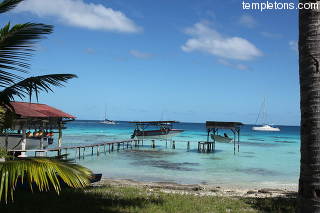Total Eclipse at Hao, French Polynesia
I got a chance to see my 5th eclipse on July 11 -- well sort of. In spite of many tools at our disposal, including a small cruise ship devoted to the eclipse, we saw only about 30 seconds of the possible 4 minutes due to clouds. But I still have a gallery of pictures.
 Many people chose the Hao atoll for eclipse viewing because of its very long airstrip and 3 minute 30 second duration. Moving north would provide even more, either from water or the Amanu atoll. Weather reports kept changing, suggesting moving north was a bad idea, so our boat remained at the Hao dock until the morning of the eclipse. In spite of storm reports, it dawned effectively cloudless so we decided to stay put and set up all instruments and cameras. Seeing an eclipse on land is best in my view, ideally a place with trees and animals and water. And it's really the only choice for good photography.
Many people chose the Hao atoll for eclipse viewing because of its very long airstrip and 3 minute 30 second duration. Moving north would provide even more, either from water or the Amanu atoll. Weather reports kept changing, suggesting moving north was a bad idea, so our boat remained at the Hao dock until the morning of the eclipse. In spite of storm reports, it dawned effectively cloudless so we decided to stay put and set up all instruments and cameras. Seeing an eclipse on land is best in my view, ideally a place with trees and animals and water. And it's really the only choice for good photography.
As the eclipse came, clouds started building, moving quickly in the brisk winds. The clouds may have been the result of eclipse-generated cooling and they did increase as the eclipse came. However, having set up we decided not to move. The clouds were fast and small and it was clear that they would not block the whole eclipse until a big cloud came just near totality which almost did. We did get 30 seconds of fairly clear skies, so the crowd of first-timers were just as awed as first timers always are. Disappointment was only felt by those who had seen a few.

I said "in theory" above because one person's computer did not start the photos properly, and he had to start them again by hand. In addition, while we forgot to use it, the photo program has an "emergency mode" for just such a contingency. This mode puts into into a quick series of shots of all major exposures, designed to be used in a brief hole in the clouds. In the panic we never thought to hit the panic button.
I was lucky last year in spite of my rush. I was fooled into thinking I could duplicate that luck. You have to learn to rehearse everything you will do during an eclipse. This also applied to my panoramas. I had brought a robotic panoramic mount controlled by bluetooth from my laptop. In spite of bringing two laptops, and doing test shots the day before, I could not get the bluetooth link going as the eclipse approached. I abandoned the robotic mount to do manual panos. I had been considering that anyway, since the robotic mount is slow and takes about 10 seconds between shots, limiting how much pano it could do. By hand I can do a shot every second or so. Of course the robot in theory takes none of my personal eclipse time, while doing the hand pano took away precious views, but taking 3 minutes means too much changing light and moving people.

More lessons learned. After the eclipse we relaxed and cruised the Atoll, swam, dove, surfed, bought black pearls and had a great time.
The next eclipse is really only visible in one reachable place: Cairns Australia in November of 2012. (There is an annular eclipse in early 2012 that passes over Redding and Reno and hits sunset at Lubbock, but an annular is just a big partial eclipse, not a total.)
Cairns and the great barrier reef are astounding. I have a page about my prior trip to Australia and Cairns and any trip there will be good even with a cloudy eclipse. Alas, a cloudy eclipse is a risk, because the sun with be quite low in the morning sky over the mountains, and worse, Nov 13 is right at the beginning of the wet season. If the wet starts then, it's probably bad news. For many, the next eclipse will be the one that crosses the USA in 2017. However, there are other opportunities in Africa/2013 (for the most keen,) Svalbard/2015 and Indonesia/2016 before then.
I'll have some panoramas in the future. Meanwhile check out the gallery. Of course I got better eclipse pictures last year.








Add new comment